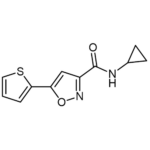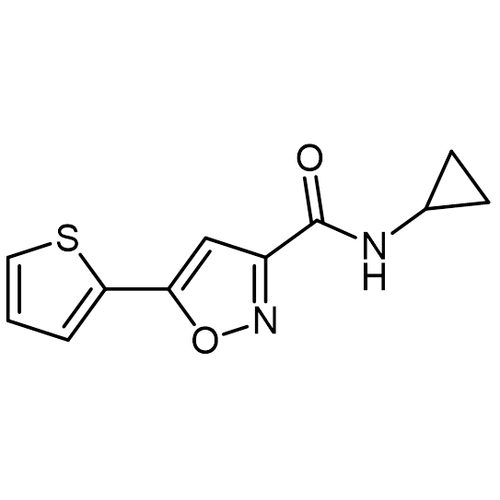| Product Name | ISX9 |
| Description |
Induces neuronal differentiation |
| Purity | >99% (TLC); NMR (Conforms) |
| CAS No. | 832115-62-5 |
| Molecular Formula | C11H10N2O2S |
| Molecular Weight | 234.3 |
| Field of Use | Not for use in humans. Not for use in diagnostics or therapeutics. For in vitro research use only. |
Properties
| Storage Temperature | -20ºC |
| Shipping Temperature | Shipped Ambient |
| Product Type | Inducer |
| Solubility | May be dissolved in DMSO (60 mg/ml): or ethanol (16 mg/ml, warm) |
| Source | Synthetic |
| Appearance | Tan powder |
| SMILES | C1CC1NC(=O)C2=NOC(=C2)C3=CC=CS3 |
| InChI | 1S/C11H10N2O2S/c14-11(12-7-3-4-7)8-6-9(15-13-8)10-2-1-5-16-10/h1-2,5-7H,3-4H2,(H,12,14) |
| InChIKey | SYENTKHGMVKGAQ-UHFFFAOYSA-N |
| Safety Phrases | Classification: Warning |
| Cite This Product | ISX9 (StressMarq Biosciences Inc., Victoria BC CANADA, Catalog # SIH-628) |
Biological Description
| Alternative Names | N-Cyclopropyl-5-(2-thienyl)-3-isoxazolecarboxamide; ISX; Isoxazole-9 |
| Research Areas | Calcium Signaling, Neuroscience, Neurotransmission, Stem Cells, Calmodulin, CamK |
| PubChem ID | 19582717 |
| Scientific Background | Promotes neurogenesis in vivo enhancing the proliferation and differentiation of hippocampal subgranular zone neuroblasts and enhances memory (1). Induces robust neuronal differentiation in adult neural stem cells (2). Increases insulin production by pancreatic βcells (3). Blocks malignant astrocyte proliferation, downregulates their astrocyte character, induces reentry into the cell cycle and upregulates neuronal gene expression (4). Induces sensory neurons from neuroepithelial stem cells (5). Potentiates cell proliferation and neuronal commitment in the rat dentate gyrus (6). |
| References |
1. D Petrick et al. FASEB J. 2012 26:3148 2. JW Schneider et al. Nat. Chem. Biol. 2008 4:408 3. EM Dioum et al. Proc. Natl. Acad. Sci. U.S.A. 2011 108:20713 4. L Zhang et al. Differentiation 2011 81:233 5. RQ Ali et al. Am. J. Stem Cells 2016 5:19 6. LE Bettio et al. Neuroscience 2016 332:212 |



Reviews
There are no reviews yet.